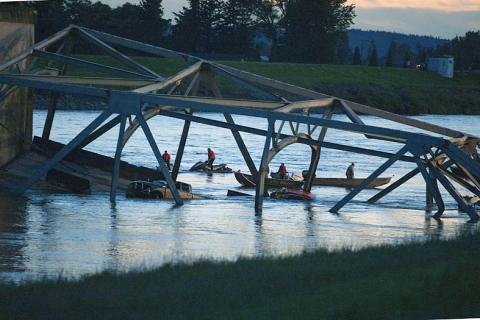The major link between the US and Canadian sides of the Pacific Northwest region was severed after a bridge collapsed, dumping a handful of vehicles and people into a river, police said.
All three people who were on the span were rescued and taken to hospitals.
The four-lane Interstate 5 bridge — more than half a century old — collapsed about halfway between Seattle and Vancouver, British Columbia, Washington State Trooper Mark Francis said.

Photo: EPA
It was caused by an oversize truck hitting the span, the Washington State Patrol chief said.
“For reasons unknown at this point in time the semi struck the overhead of the bridge, causing the collapse,” Chief John Batiste told an overnight news conference.
The truck made it off the bridge and the driver remained at the scene and cooperated with investigators.
The collapse came at the start of one of the busiest holiday weekends of the year in the US, Memorial Day weekend.
The collapse came before sundown on a clear day.
The state Transportation Department said it was investigating whether an oversize truck load may have struck the bridge.
Dan Sligh and his wife were in their pickup truck on Interstate 5 heading to a camping trip when the bridge before them disappeared in a “big puff of dust.”
Sligh, his wife and another man in a different vehicle were dumped into the chilly waters of the Skagit River when the span collapsed on Thursday evening. They were injured, but authorities said it appeared nobody was killed in the bridge failure that raised questions about the safety of aging spans.
“We don’t think anyone else went into the water,” said Marcus Deyerin, a spokesman for the Northwest Washington Incident Management Team. “At this point we’re optimistic.”
Sligh and his wife were taken to Skagit Valley Hospital with non-life-threatening injuries. The other man was reported in stable condition at United General Hospital in Sedro-Woolley, hospital chief executive officer Greg Reed said.
Authorities were trying to determine what caused the bridge to collapse about 100km north of Seattle in Skagit County.
Traffic along the heavily traveled route could be affected for some time.
“The I-5 corridor is totally disrupted,” said Governor Jay Inslee, who went to the scene on Thursday night.
The National Transportation Safety Board was sending an investigative team.
Francis said a portion of the four-lane bridge over the Skagit River collapsed about 7pm.
Jeremiah Thomas, a volunteer firefighter, said he was driving nearby when he glimpsed something out of the corner of his eye and turned to look.
“The bridge just went down, it crashed through the water,” he said. “It was really surreal.”
The bridge was about 15m above the water.
Deyerin said it appeared that two vehicles — a car and the pickup with the travel trailer attached — fell into the river.
He said the water depth was about 4.5m, and the vehicles half-visible in the water were likely resting on portions of the collapsed bridge.
Crowds of people lined the river to watch the scene unfold.
“It’s not something you see every day,” said Jimmy O’Connor, the owner of two local pizza restaurants who was driving on another bridge parallel to the one that collapsed.
The bridge was not classified as structurally deficient, but a US Federal Highway Administration database listed it as being “functionally obsolete” — a category meaning that the design is outdated, such as having narrow shoulders and low clearance underneath.
The bridge was built in 1955 and has a sufficiency rating of 57.4 out of 100, according to federal records.
That is well below the statewide average rating of 80, according to an Associated Press analysis of federal data, but 759 bridges in the state have a lower sufficiency score.
According to a Skagit County Public Works Department report published last year, 42 of the county’s 108 bridges are 50 years or older.
The document says eight of the bridges are more than 70 years old and two are over 80.
Washington state was given a C in the American Society of Civil Engineers’ 2013 infrastructure report card and a C- when it came to the state’s bridges. The group said more than a quarter of Washington’s 7,840 bridges are considered structurally deficient or functionally obsolete.

The combined effect of the monsoon, the outer rim of Typhoon Fengshen and a low-pressure system is expected to bring significant rainfall this week to various parts of the nation, the Central Weather Administration (CWA) said. The heaviest rain is expected to occur today and tomorrow, with torrential rain expected in Keelung’s north coast, Yilan and the mountainous regions of Taipei and New Taipei City, the CWA said. Rivers could rise rapidly, and residents should stay away from riverbanks and avoid going to the mountains or engaging in water activities, it said. Scattered showers are expected today in central and

COOPERATION: Taiwan is aligning closely with US strategic objectives on various matters, including China’s rare earths restrictions, the Ministry of Foreign Affairs said Taiwan could deal with China’s tightened export controls on rare earth metals by turning to “urban mining,” a researcher said yesterday. Rare earth metals, which are used in semiconductors and other electronic components, could be recovered from industrial or electronic waste to reduce reliance on imports, National Cheng Kung University Department of Resources Engineering professor Lee Cheng-han (李政翰) said. Despite their name, rare earth elements are not actually rare — their abundance in the Earth’s crust is relatively high, but they are dispersed, making extraction and refining energy-intensive and environmentally damaging, he said, adding that many countries have opted to

African swine fever was confirmed at a pig farm in Taichung, the Ministry of Agriculture said today, prompting a five-day nationwide ban on transporting and slaughtering pigs, and marking the loss of Taiwan’s status as the only Asian nation free of all three major swine diseases. The ministry held a news conference today confirming that the virus was detected at a farm in Wuci District (梧棲) yesterday evening. Authorities preemptively culled 195 pigs at the farm at about 3am and disinfected the entire site to prevent the disease from spreading, the ministry said. Authorities also set up a 3km-radius control zone

CONCESSION: A Shin Kong official said that the firm was ‘willing to contribute’ to the nation, as the move would enable Nvidia Crop to build its headquarters in Taiwan Shin Kong Life Insurance Co (新光人壽) yesterday said it would relinquish land-use rights, or known as surface rights, for two plots in Taipei’s Beitou District (北投), paving the way for Nvidia Corp to expand its office footprint in Taiwan. The insurer said it made the decision “in the interest of the nation’s greater good” and would not seek compensation from taxpayers for potential future losses, calling the move a gesture to resolve a months-long impasse among the insurer, the Taipei City Government and the US chip giant. “The decision was made on the condition that the Taipei City Government reimburses the related